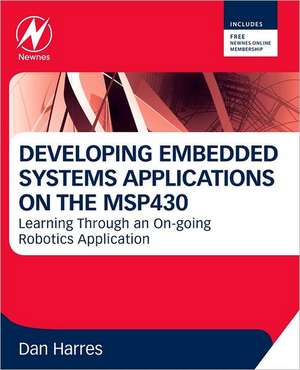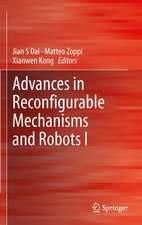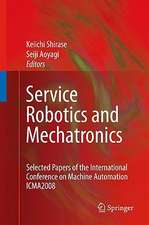MSP430-based Robot Applications: A Guide to Developing Embedded Systems
Autor Dan Harresen Limba Engleză Paperback – 24 apr 2013
Key features include:
- Thorough treatment of the MSP430’s architecture and functionality along with detailed application-specific guidance
- Programming and the use of sensor technology to build an embedded system
- A learn-by-doing experience
- The basic theory for electronics design
- Digital logic
- Computer arithmetic
- Microcontroller programming
- How to design and build a working robot
- Assembly language and C programming
- How to develop your own high-performance embedded systems application using an on-going robotics application
- Teaches how to develop your own high-performance embedded systems application using an on-going robotics application
- Thorough treatment of the MSP430’s architecture and functionality along with detailed application-specific guidance
- Focuses on electronics, programming and the use of sensor technology to build an embedded system
- Covers assembly language and C programming
Preț: 279.38 lei
Preț vechi: 348.31 lei
-20% Nou
Puncte Express: 419
Preț estimativ în valută:
53.48€ • 58.11$ • 44.95£
53.48€ • 58.11$ • 44.95£
Carte tipărită la comandă
Livrare economică 14-28 aprilie
Preluare comenzi: 021 569.72.76
Specificații
ISBN-13: 9780123970121
ISBN-10: 0123970121
Pagini: 416
Ilustrații: Illustrations
Dimensiuni: 191 x 235 x 23 mm
Greutate: 0.66 kg
Editura: ELSEVIER SCIENCE
ISBN-10: 0123970121
Pagini: 416
Ilustrații: Illustrations
Dimensiuni: 191 x 235 x 23 mm
Greutate: 0.66 kg
Editura: ELSEVIER SCIENCE
Public țintă
Professional electronics engineers, embedded designers and programmers; students taking a course using microcontrollers. Individuals with an electronics background who may (or may not) have previous experience with microcontrollers, but who are just getting started with the TI MSP430 microcontroller.Cuprins
1. Introduction; 2. The Parts of a Robot; 3. Building an Inexpensive Robot by Modifying a Radio-Controlled Car; 4. Beginning Electronics; 5. Computer Arithmetic; 6. Computer Logic; 7. Introducing the MSP430 Microcontroller; 8. Starting to Program – An Introduction to MSP430 Assembler; 9. Building MSP430 Assembler Programs; 10. Introducing C for the MSP430; 11. More C and Mixing C With Assembler; 12. MSP430 Parallel and Serial Ports; 13. MSP430 Timing, Counters, and Interrupts; 14. MSP430 Data Acquisition; 15. Inexpensive Ways to Perform Circuit Simulation; 16. Prototyping Circuits; 17. Collision Avoidance; 18. Adding a Tachometer; 19. Controlling Things With a Remote; 20. Troubleshooting; 21. The Working, High-Performance Robot
Recenzii
"This book teaches readers how to build a robot based on the Texas Instruments (TI) MSP430 microcontroller. To make things clear, the author presents a concrete case: creating a basic robot from a simple radio-controlled car. Enthusiasts are targeted: high school and college students eager to build their first robots, and computer geeks wishing to drill down to the machine level." --ComputingReviews.com, January 2014
"The Texas Instruments MSP430 is a small, low power consumption microcontroller with a wide range of uses in embedded devices. In this book, Harres provides a guide to using them in robotics projects. The book emphasizes a hands-on approach where the reader will learn about robotics by constructing actual robots. The reader is not assumed to have any advanced technical background beyond algebra, trigonometry, basic programming knowledge, soldering skills, and high school level knowledge of electromagnetic physics." --Reference & Research Book News, December 2013
"The Texas Instruments MSP430 is a small, low power consumption microcontroller with a wide range of uses in embedded devices. In this book, Harres provides a guide to using them in robotics projects. The book emphasizes a hands-on approach where the reader will learn about robotics by constructing actual robots. The reader is not assumed to have any advanced technical background beyond algebra, trigonometry, basic programming knowledge, soldering skills, and high school level knowledge of electromagnetic physics." --Reference & Research Book News, December 2013



























